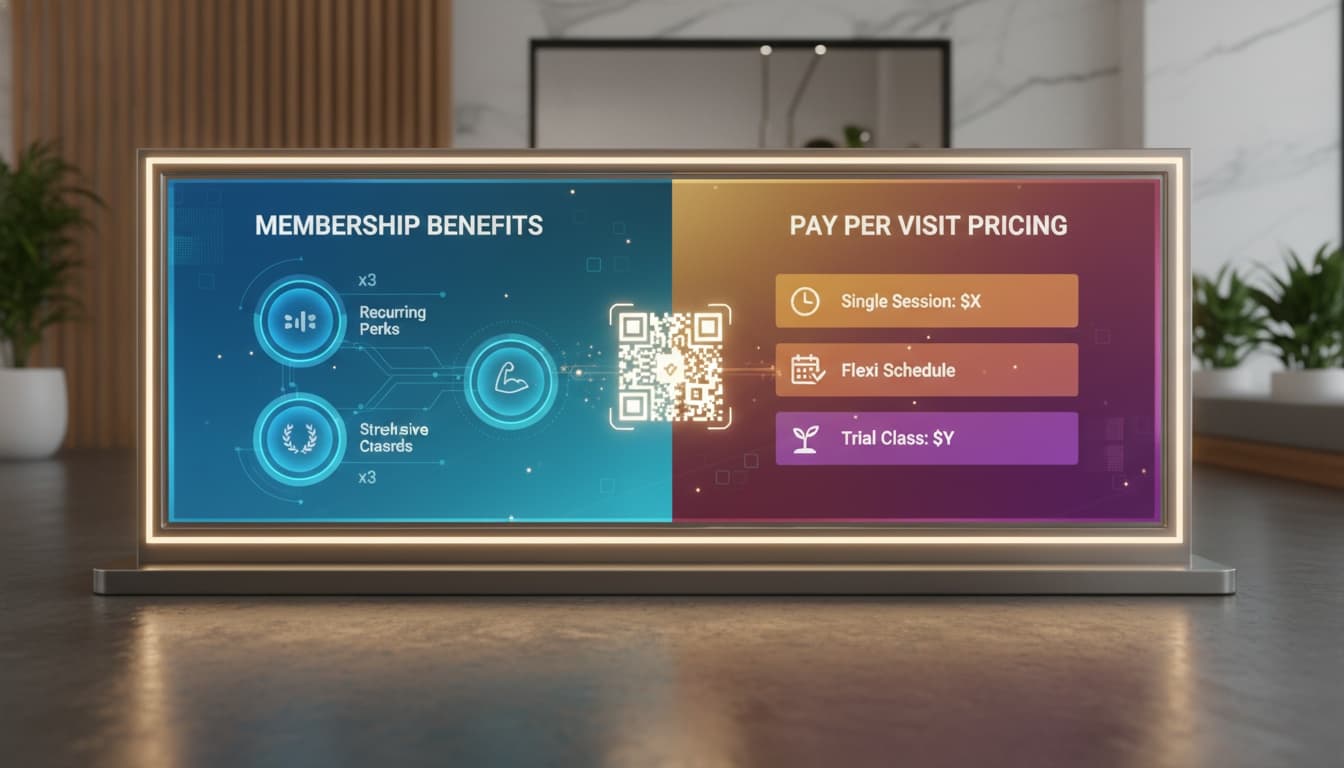Service businesses often struggle to decide whether a membership model or a pay per visit structure works best for long term growth. Salons, gyms, clinics, spas, and wellness providers each have different operational realities. Yet the core decision depends on financial stability, client behavior, retention patterns, and the psychological triggers that influence commitment. Understanding both models deeply allows you to pick the best approach or even combine them in a hybrid structure.
This comparison guide explains the economics behind each model, the psychology that drives client behavior, break even calculations, hybrid ideas, and how QR engagement enhances both systems. You will also see practical examples from salons, gyms, and clinics.
Choose the model that drives predictable growth
Use data, psychology, and QR engagement to build a revenue model that matches your service goals.
Understanding the financial models
The financial difference between membership and pay per visit structures comes down to predictability. Memberships generate recurring revenue, allowing accurate forecasting and higher lifetime value. Pay per visit creates flexibility and accessibility but introduces revenue volatility.
Membership revenue characteristics:
• Predictable recurring revenue. • Higher lifetime value. • Lower churn when benefits are clear. • Easier staffing and resource planning.
Pay per visit revenue characteristics:
• Flexible for clients. • Attractive for low commitment users. • Easy for new clients to try. • Higher seasonal variability.
For many service providers, the best strategy is not choosing one model but optimizing both. Hybrid systems often outperform single model structures.
Client psychology behind each model
Memberships tap into identity and commitment psychology. When clients subscribe, they view themselves as ongoing participants. This creates habit reinforcement and lowers resistance to regular usage. Pay per visit leverages freedom psychology. Clients avoid feeling locked in and appreciate the ability to choose based on convenience or need.
Membership psychological triggers:
• Identity reinforcement (“I’m a member”). • Loss aversion (don’t waste the membership). • Habit formation (recurring cycles). • Emotional attachment to service providers.
Pay per visit psychological triggers:
• Flexibility and autonomy. • Low risk entry. • Freedom from commitment. • Perfect for occasional users.
Understanding these triggers helps match each model to the right client segment.

Retention patterns of memberships vs pay per visit
Memberships generally produce higher retention because they create structure and recurring cycles. However, they also carry a risk: if the perceived value drops, cancellations spike. Pay per visit clients show lower retention but can be nurtured into repeat customers with strong follow up flows.
Membership retention patterns:
• Stable once habits form. • Stronger loyalty when clients track progress. • Vulnerable to perceived value drops or service inconsistency.
Pay per visit retention patterns:
• Irregular and inconsistent. • High no show rates without reminders. • Strong improvement with QR based follow ups and rebooking nudges.
Using VISU Push Ads improves the retention of both groups by delivering timely nudges.
Break even calculations for each model
Break even math helps determine which model is more profitable for your business. Membership profitability depends on utilization rates and cost structures. Pay per visit profitability depends on volume and margin per service.
Membership break even factors:
• Service delivery costs per session. • Average usage frequency. • Monthly membership price. • Churn rate.
Pay per visit break even factors:
• Price per service. • Cost per service. • Average number of visits per client. • Seasonal variations.
A membership becomes more profitable the moment the client’s monthly payment exceeds their cost of service delivery. Data captured through QR journey tracking gives clarity on usage patterns, helping refine the pricing.
Hybrid model ideas that work across industries
Hybrid models combine the best of both worlds. They offer commitment for clients who want structure and flexibility for clients who prefer ad hoc visits.
Examples of hybrid setups:
• Low tier membership plus discounted pay per visit add ons. • Class or session packs that behave like semi memberships. • Wellness subscriptions paired with à la carte upgrades. • Salon membership for treatments plus pay per visit styling.
Hybrid systems also allow you to segment clients gracefully. High commitment users join memberships. Flexible users pay per visit but still receive QR based nudges that increase frequency.

How QR based engagement improves both models
QR interactions enhance both membership and pay per visit systems by making engagement dynamic, educational, and personalized. QR journeys allow you to guide clients through the right flows at the right moment.
Membership QR flows:
• Progress dashboards. • Streak tracking. • Monthly benefits reveal. • Exclusive content or upgrades.
Pay per visit QR flows:
• Rebooking prompts. • Aftercare guides. • Loyalty points.
• Personalized recommendations.
In all cases, QR flows turn irregular behavior into consistent habits.
Examples across salons, gyms, and clinics
Salon example: Membership for monthly treatments like hydration or coloring plus pay per visit styling and add ons.
Gym example: Membership for unlimited classes combined with pay per visit specialty sessions or premium workshops.
Clinic example: Membership for ongoing monitoring plus pay per visit tests, evaluations, or treatments.
These examples show how both models coexist naturally when structured well.
Pick the model that aligns with your clients
Use financial data, psychology, and QR engagement flows to build a membership or pay per visit structure that drives sustainable growth.

